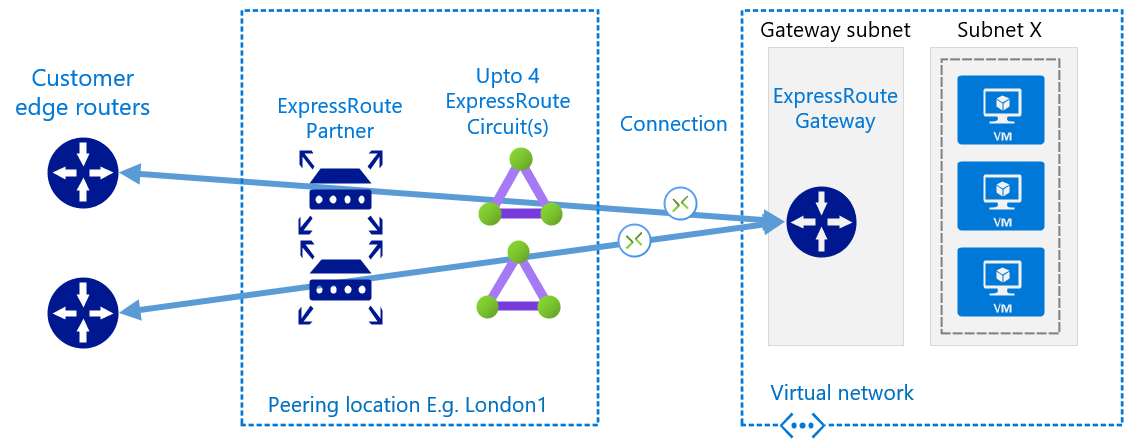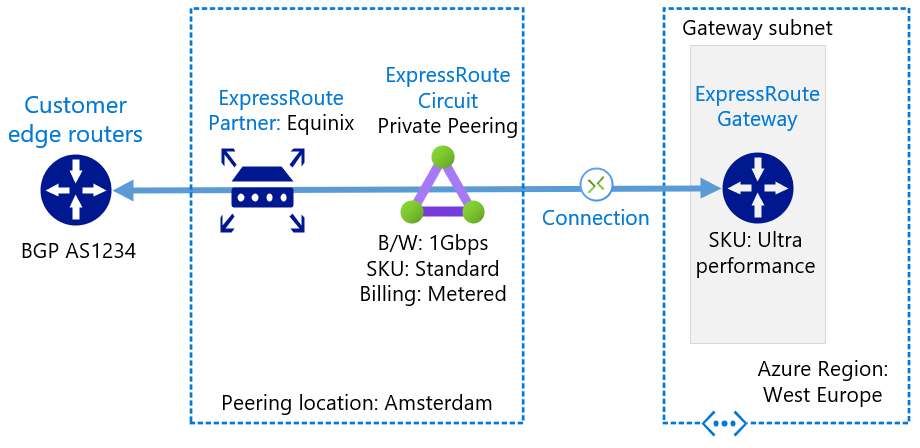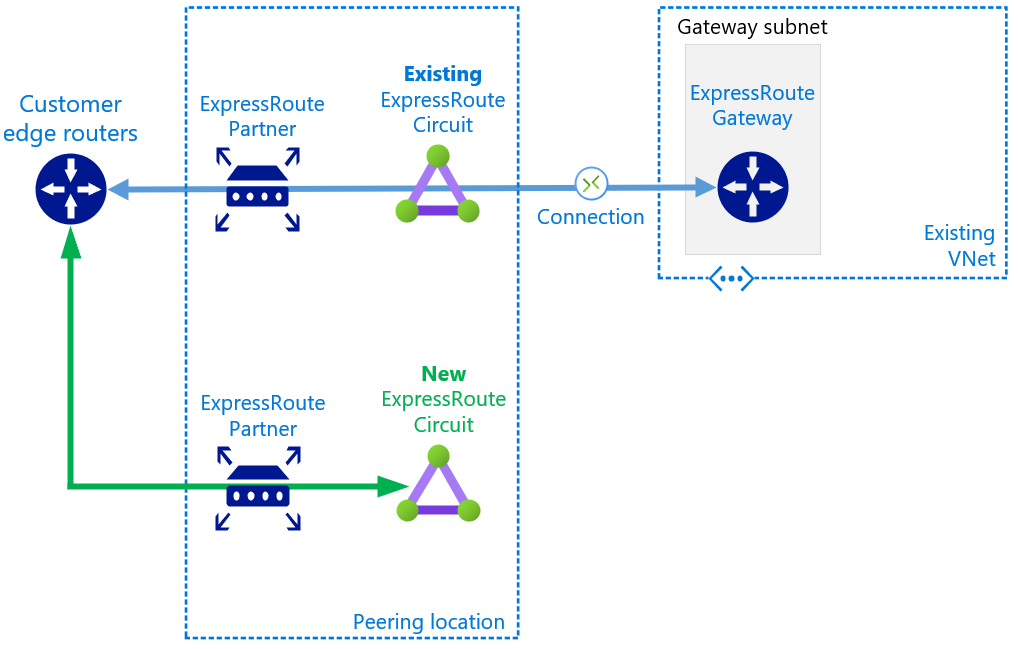- 1. Introduction
- 2. Context
- 3. Private Peering Migration
- 3.1. Create new ExpressRoute circuit
- 3.2. Create test Virtual Network and link to circuit
- 3.3. Pre-provision circuit authorizations
- 3.4. Configure BGP routing to favour existing circuit
- 3.5. Connect new circuit to existing ExpressRoute Gateway
- 3.6. Move traffic to new ExpressRoute circuit
- 3.7. Validate
- 3.8. Rollback
- 3.9. Cleanup
- 4. Public/Microsoft Peering Migration
- 5. Further reading
Many customers on Azure leverage ExpressRoute for reliable hybrid connectivity. Sometimes these same customers may need to implement a new ExpressRoute circuit, and have a desire to decommission their old circuit. Common drivers for this scenario include:
- Mergers and acquisitions resulting in consolidation of network providers
- Moving an ExpressRoute circuit from one Azure subscription to another Azure subscription
- A change of ExpressRoute provider or incumbent WAN provider
- Downgrading an ER circuit bandwidth requires a new circuit
- Upgrading an ER circuit can sometimes require a new circuit, depending if the existing underlying port has capacity to support the bandwidth increase
This guides suggest an approach to this migration process that focuses on seamless failover, de-risking rollback, and understanding the correct ordering of steps. Each step will require you to leverage your existing knowledge of ExpressRoute, links will be provided to Azure documentation as required for further technical depth.
⚠️ This document assumes pre-existing knowledge of Azure, ExpressRoute and BGP. It is not designed to be read in isolation, but rather act as a high level guide, pointing you in the right direction, at the right places and get the project team asking the right questions to plan for success.
PS. There is now an official doc similar to this one, located here https://learn.microsoft.com/en-us/azure/expressroute/circuit-migration
When having any ExpressRoute discussion its beneficial to agree on terms. This is best visualized in layers, highlighting the different components in any ExpressRoute design;
- Gateway; lives in the GatewaySubnet in your Virtual Network (VNet)
- Connection; connects your Gateway to a Circuit.
- Circuit; the logical configuration at the Microsoft edge network, used to connect your network to ours. Not located in the Azure Region, lives in the Peering Exchange, aka Edge site, aka PoP. Owned by companies like NGN, Equinix and Telehouse.
- Partner; The company helping you bridge the gap between your network and Microsoft's by facilitating, most commonly, a collection of virtual layer-2 circuits, which you connect to your Customer network equipment.
- Customer; Your devices, most often used for Layer-3 BGP termination.
Customer/partner lines may blur, also ExpressRoute Direct removes the Partner layer.
This document presents migration steps with a simple scenario in mind; "I have one existing ExpressRoute circuit, I am implementing a new ExpressRoute circuit, how do I get from A to B?". The logic and approach herein can be used for more complex scenarios involving multiple circuits (before or after migration), multiple Azure regions and/or multiple ExpressRoute Gateways.
Up until ~2019 it was only possible to connect a unique peering location to an ExpressRoute Gateway with a single ExpressRoute circuit. I.e. you could link multiple circuits to an ER Gateway, but they had to be from different peering locations. Today, this limit is raised, we are able to simultaneously link up to 4 circuits from the same peering location to an ExpressRoute gateway. This gives us more flexibility when planning the approach to migration.
I.e. the following is now possible.
If, as part of your ExpressRoute migration project, you are implementing more circuits for resilience, make sure to also consider the ExpressRoute Gateway SKU you are using. This should be fit for purpose and aligned with your resilience and performance goals. If you are scheduling maintenance windows to upgrade your circuit, now could be a good time to plan for Gateways changes, if they are required.
Do also pay close attention to platform limits associated with number of connections/authorisations per circuit, and number of circuits per gateway.
A common ExpressRoute anti-pattern (don't do this 😀 ); in the diagram below, an outage affecting a single Availability Zone in the Azure region has the possibility of taking your entire Hybrid Connection offline (due to all instances of the Gateway becoming unavailable, if they happen to reside in the AZ having issues). This would clearly work against your overall strategy of leveraging Availability Zones for your applications and data.
In the diagram above we would recommend moving to the ErGw3Az SKU; offering the same throughput capabilities as the Ultra Performance SKU, but with the added benefit of AZ resilience.
Before removing the old connectivity, we should capture its logical configuration and form a baseline diagram to iterate from. Important information includes;
- Which Azure regions are being used, E.g. West Europe
- ExpressRoute Gateway SKU, e.g. High, or ERGw1Az
- ExpressRoute connection objects (the things that link a gateway to a circuit within the same subscriptions)
- ExpressRoute authorisations (the things that link a gateway to a circuit within a different subscription)
- ExpressRoute circuit attributes
- Peering location, e.g. London1
- Bandwidth, e.g. 1Gbps
- Provider, e.g. Equinix
- SKU, e.g. Standard/Premium/Local
- Billing Model, e.g. Unlimited/Metered
- ExpressRoute circuit peering types
- Private peering (the majority of customers will only be using this peering type)
- Public Peering (now deprecated, but may still be in use in your network)
- Public Peering utilises Microsoft managed SNAT ranges. If you do not know this SNAT information, you will need to raise an Azure support ticket to find out your SNAT addresses
- Microsoft Peering
- Microsoft peering utilises customer managed SNAT, you or your provider will have this information.
- Route filters associated with Microsoft peering
- BGP information - AS numbers and /30 peer IP addresses for all peerings
Once this is complete, you should be able to produce two diagrams similar to the below, splitting out the Private Peering and the Public/Microsoft Peering for clarity.
Follow this guide to create the new circuit with your requirement parameters. This includes working with your provider to turn-up the new circuit and configure the BGP peerings to your network. The /30 BGP links will utilise new, unique IP addressing. You may also decide to deploy the ExpressRoute circuit and remaining configurations via alternative methods such as PowerShell, Azure CLI or Bicep, Terraform, REST etc.
- Create a new VNet with some test IP address space that does not overlap with either your current on-premises address space, or your existing Azure VNet(s) address space
- Deploy, for testing purposes, both a Virtual Machine and an ExpressRoute Virtual Network Gateway
- Connect the test Gateway to your new circuit via a Connection object
- The purposes of this step is to prove out end-to-end connectivity across the new circuit, prior to using it within your production environment.
- If done correctly, your On-Premises network can now route traffic to this new test VNet, and vice versa
- Carry out part of your required commissioning tests, latency, throughput etc
Take this opportunity to become familiar with all the rich ExpressRoute information that is available from the CLI. For example, a good idea at this step is to verify you are advertising all the required routes from On-Premises with the expected AS-PATH manipulation, if any. A great guide to get started https://blog.cloudtrooper.net/2021/07/12/cli-based-analysis-of-an-expressroute-private-peering/
If you are using circuit authorizations for cross-subscription gateway attachment (you checked that already right? 😀 ) Then you are able to deploy these ahead of time on the new circuit. Generate the new authorizations and they will remain in the "available" state until redeemed at the gateway level. One less job to do during the migration window itself.
Before we attach our new circuit to the production ExpressRoute Gateway, we want to ensure that traffic only fails over to this circuit when we decide, and not unexpectedly due to routing logic we may not have full visibility of. We want to do this to ensure that traffic to and from Azure remains symmetrical, this is especially important if On-Premises stateful firewalls are in use.
- To control traffic from Azure to On-Premises the most straight forward method is to change the Weight parameter, configured at the Connection object level. The default is 0, a higher weight wins, therefore lets set our existing connection to 100.
- An alternative method to control traffic from Azure to On-Premises is to use AS-PATH from On-Premises in the direction of Azure - full details. Here is an example of a circuit that is receiving AS-PATH prepended routes from an On-Premises router.
- To control traffic from On-Premises to Azure you will need to use BGP metric tuning - typically AS-PATH inbound, or local preference, depending on exact topology of your Customer edge routers. Configure a route-map on your on-premises router. Leverage this route-map to manipulate BGP metrics on routes received from Azure via the existing blue circuit. E.g. Configure your route-map to set Local Preference to 200. (Higher local pref wins, default is typically 100).
Note! At this stage the circuit is still not connected to your existing/production ExpressRoute Gateway, but you have verified the route advertisements and attributes.
At this point we have a high degree of confidence in the new circuit; we have proved end-to-end connectivity and we understand, and are in control of, the routing behaviour on the existing circuit, we can attach the new circuit to operate in a standby/passive state.
- Create a new connection object that links your new circuit to your ExpressRoute Gateway, ensure the Weight is set to 0.
- Now is the time to also redeem the authorsations you created in an earlier step, effectively building connections from your circuit to gateways that reside in different subscriptions. Again, don't forget to set Weight to 0.
- Verify, using AZ CLI, that the ExpressRoute gateway sees your on-premises prefixes via both circuits, and if using AS-PATH manipulation inbound, that the AS-PATH attributes are as you expect.
The example below shows my On-Premises prefix of 192.168.2.0/24 being learnt via 4 BGP neighbours (each ER circuit is represented by peerings to the Gateway), representing my lab configuration that uses two ER circuits.
Note visibility of BGP route metrics including AS-PATH and weight (additive beyond baseline of 32xxx), allowing you to verify configuration changes made in step 3.4.
az network vnet-gateway list-learned-routes -n ER-GW-WE -g GBB-ER-LAB-WE -o table
Network Origin SourcePeer AsPath Weight NextHop
----------------- -------- ------------ ----------------------------------- -------- ----------
192.168.2.0/24 EBgp 10.10.1.6 12076-65000-65001-65001-65002 32869 10.10.1.6
192.168.2.0/24 EBgp 10.10.1.7 12076-65000-65001-65001-65002 32869 10.10.1.7
192.168.2.0/24 EBgp 10.10.1.5 12076-65000-65001-65001-65001-65002 32769 10.10.1.5
192.168.2.0/24 EBgp 10.10.1.4 12076-65000-65001-65001-65001-65002 32769 10.10.1.4
Until now we have been in the verification and test phase, now its time to move production traffic on to our new circuit. At this point we have two options;
- a) Delete the connection object that links your old circuit to your ExpressRoute Gateway. In effect, forcing traffic to/from Azure over your new circuit. This will incur downtime whilst the logical network routing catches up; between 10s to ~240s depending on the configuration of your On-Premises network, existing ER circuit and if you are using BFD or not.
- b) Modify BGP metrics to preference the new circuit, using the logic from step 3.4 to de-preference the old circuit. E.g. we set Weight to 200 on the connection object and, in parallel, change our On-Premises route-maps to prefer the new circuit. In my testing this approach can result in a more seamless failover and less downtime, but your mileage may vary, depending on your On-Premises network setup.
Which approach you choose will depend on factors such as;
- Who is driving the migration? I would suggest that you always need your On-Premises network team involved in the migration process, but option (a) allows the cut-over to be initiated entirely from Azure.
- Are any On-Premises firewalls being used? Option (a) guarantees symmetrical traffic, whilst option (b) may result in temporary asymmetry due to BGP propagation timing
- Appetite for downtime. Option (a), whilst simpler, does come with the guaranteed downtime whilst BGP re-converges. Option (b) is more complex, but may offer a more seamless cut-over experience
You have now completed either option (a) or (b) above, you believe everything is working, how can we rubber stamp this and consider the migration a success?
-
To verify traffic from Azure to On-Premises is using the correct path
- From the ExpressRoute Gateway, you can re-run the command from earlier (
az network vnet-gateway list-learned-routes -n <gatewayname> -g <rg> -o table) and verify that the preferred route (via weight, or AS-PATH) has now flipped over to your other circuit.
- From the ExpressRoute Gateway, you can re-run the command from earlier (
-
To verify traffic from On-Premises to Azure is using the correct path
- Check your customer edge device, run (for Cisco folks, or equivalent of)
show ip bgp <azure vnet prefix>, the best path should represent the next-hop of your new circuit peerings IP addressing.
- Check your customer edge device, run (for Cisco folks, or equivalent of)
Corroborate the above by checking the ExpressRoute circuit metrics in Azure Monitor, this can be accessed right from the metrics blade in the portal. You should see traffic drop off your old circuit, and ramp up on your new circuit. In the below screenshot I have applied two metrics (bits-in and bits-out) along with splitting to force peering-type=private, finally I set time-range to last 30 minutes.
Now might also be a good time to solidify your investment of time in Monitoring for your shiny new ExpressRoute circuit, take a look at the new Connection Monitor experience, superseding Network Performance Monitor going forward.
What if things are not working? Your app owners are still reporting problems after a period of UAT, and you need to press the go back button?
-
If you went with option (a), reconnect the old circuit by re-creating a connection object that links the old circuit to the ExpressRoute gateway. Also remember to rebuild any circuit-to-gateway connections that utilised authorsations.
-
If you went with option (b), reverse your weight and AS-PATH metric changes
Once you are happy the migration was a success, don't forget to ask your provider to decommission your old ExpressRoute circuit, once this is complete you can delete the ExpressRoute object itself in the Azure portal. You can also remove the test VNet and associated resources.
Public Peering is now deprecated but you may still be using this service on your old circuit. If you wish to retain access to Public IPs from Microsoft over your ExpressRoute connection, you will need to implement the Microsoft peering on your new circuit.
Note! Now is a good time to assess what you are using the existing Public or Microsoft peering for. Many customers find that with platform enhancements in recent years such as Azure Private Link, the requirement to utilise the Microsoft peering is greatly reduced.
The process for migrating from Public Peering to Microsoft Peering is already well documented - https://docs.microsoft.com/en-us/azure/expressroute/how-to-move-peering - this methodology can be followed when implementing a new circuit, therefore there is no need to repeat the guidance here.
- If you are moving from Public to Microsoft peering your SNAT IP addresses will change, therefore any IP allowed-lists (for example on Azure Storage firewall) will require updating prior to cut-over.
- To obtain your existing Microsoft SNAT IP addresses used on the Public Peering, raise an Azure support ticket
- When initially configured, you will receive no routes on the Microsoft Peering. Only when attaching a route filter will you start to receive prefixes from Microsoft. https://docs.microsoft.com/en-us/azure/expressroute/how-to-routefilter-portal.
- You can use this to your advantage, initially selecting only one obscure BGP community, to validate route advertisements are functioning.
- Once this is complete, you can then select the wider range of services (BGP communities) that you require.
- This approach allows a controlled migration, on a per service basis if you desire, when combined with BGP attribute manipulation (AS-PATH prepend inbound, or local-preference).
- If your current Public/Microsoft peering is authorised for use of M365, ensure to consider this moving forward. Take this opportunity to question if you still need to send M365 traffic over ExpressRoute? Authorisation to utilise this pattern is done on a per Azure subscription basis, therefore if your new circuits will reside in a new subscription, you will have to repeat the approval request.
-
https://docs.microsoft.com/en-us/azure/expressroute/expressroute-faqs
-
Go (much) deeper on how to control BGP in respect to ExpressRoute traffic engineer, thanks to Jeremy Wright, https://github.com/jwrightazure/lab/tree/master/Expressroute-Multicircuit-ASprepend-Localpref


















